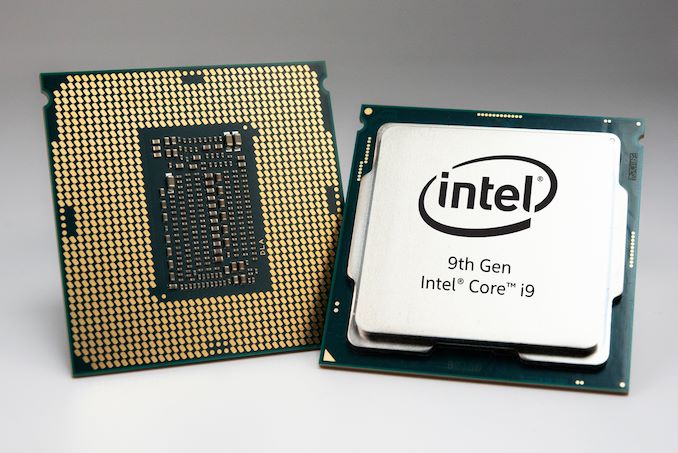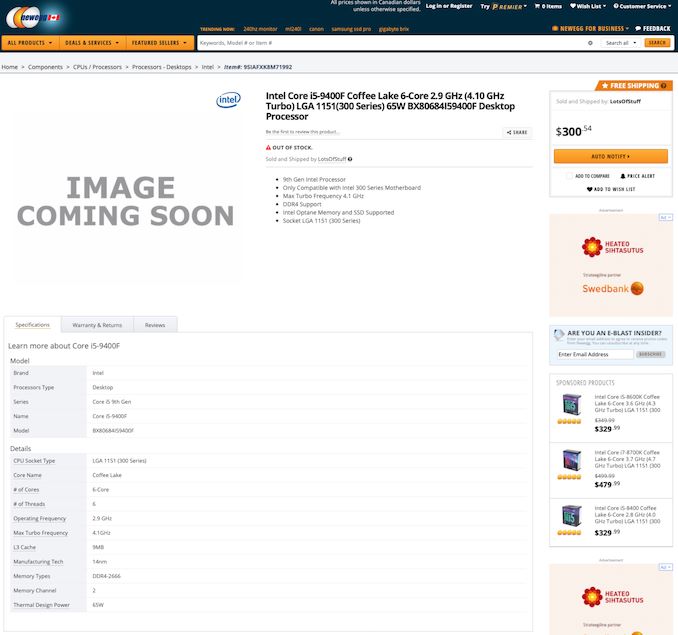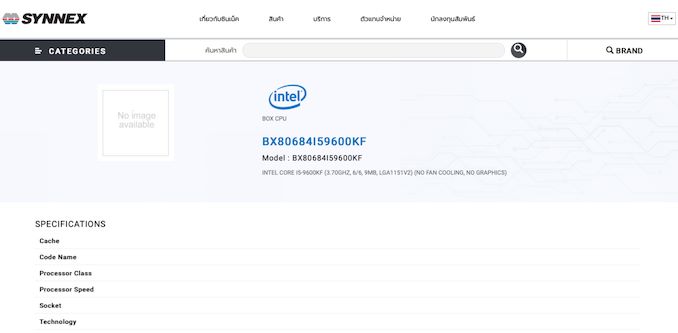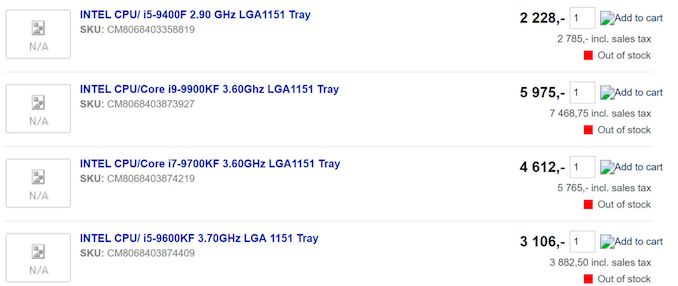Unannounced Intel Core i9-9900KF, i7-9700KF, i5-9600KF and i5-9400F CPUs Listed
by Anton Shilov on December 28, 2018 5:00 PM EST- Posted in
- CPUs
- Intel
- Coffee Lake
- Core 9th Gen

So far Intel's 9th Gen Core on desktop only features three models aimed at the higher end of the spectrum. The launch of the lineup consisting of these three products with unlocked multiplier does not yet have any “locked” parts aimed at mainstream PCs, although we are expecting them at some point. The question is one of when they will come. As it appears, from listings of numerous companies in the supply chain, Intel is finally gearing up to expand its Coffee Lake Refresh family with new models.
The products in question are the eight-core Core i9-9900KF and Core i7-9700KF, as well as the six-core Core i5-9600KF and Core i5-9400F. These devices have been listed by retailers Data-Systems.Fi, Newegg, and distributor Synnex (see screenshots below). According to Intel’s existing nomenclature, the CPUs with model numbers ending with F, like 9400F lack integrated graphics, so we suspect the new processors will primarily target higher-end systems featuring discrete graphics. This will mark the first time that Intel has launched integrated graphics-free processors in its mainstream family at the high-end for many, many years.
The higher-end Core i9-9900KF, Core i7-9700KF, and Core i5-9600KF look set to run at the same frequencies and feature the same cache configurations as their non-F colleagues. As for the Core i5-9400F, this six-core chip runs at 2.9/4.1 GHz, well below the clocks of the i5-9600K, but will have a TDP of 65 W. All of these parts, according to the listings, will be able to be used in current 300-series motherboards.
| Intel's 9th Gen Core Processors for LGA1151 v2 | ||||||||
| AnandTech | Cores | TDP | Freq | L3 | DRAM DDR4 |
iGPU | iGPU Turbo |
|
| Core i9-9900K | $488 | 8 / 16 | 95 W | 3.6 / 5.0 | 16 MB | 2666 | GT2 | 1200 |
| Core i9-9900KF* | ? | - | - | |||||
| Core i7-9700K | $374 | 8 / 8 | 95 W | 3.6 / 4.9 | 12 MB | 2666 | GT2 | 1200 |
| Core i7-9700KF* | ? | - | - | |||||
| Core i5-9600K | $262 | 6 / 6 | 95 W | 3.7 / 4.6 | 9 MB | 2666 | GT2 | 1150 |
| Core i5-9600KF* | ? | - | - | |||||
| Core i5-9400F | ? | 6 / 6 | 65 W | 2.9 / 4.1 | 9 MB | 2666 | - | - |
| *These CPUs has not been launched officially, specifications have not been confirmed. | ||||||||
Intel has not officially confirmed existence of these CPUs, or mentioned plans to release them. In the meantime, listing of the Core i5-9600KF by Newegg and the Core i5-9400F by Synnex Thailand indicates that their launch is likely imminent. Avid readers will remember that CES 2019 is taking place in early January, so the question is whether Intel starts to sell these CPUs more or less quietly ahead of CES, or if it will announce them publicly at the trade show.
In any case, if Intel proceeds with the launch (or rather when), it may broaden availability of its latest eight-core and six-core CPUs both in terms of physical availability and in terms of pricing (i.e., the i9-9900KF will hopefully cost less than the i9-9900K). In the meantime, one has to remember that Intel has high demand issues in general, so the effect of the launch is something that remains to be seen. It could be that the company will not focus on the Pentium/Celeron parts this time around, but instead make these higher-performing (and higher margin) offerings more regular.
Screenshots:
Related Reading:
- The Intel 9th Gen Review: Core i9-9900K, Core i7-9700K and Core i5-9600K Tested
- Analyzing Core i9-9900K Performance with Spectre and Meltdown Hardware Mitigations
- Intel Announces 9th Gen Core CPUs: Core i9-9900K (8-Core), i7-9700K, & i5-9600K
- Intel Coffee Lake Refresh: Global Price Check on 9900K, 9700K, 9600K
Source: Newegg, Synnex, Tom’s Hardware














60 Comments
View All Comments
nevcairiel - Saturday, December 29, 2018 - link
PS:Unless I'm mistaken, ARM 64-bit cores can also run ARM 32-bit code. Clearly the architecture is also a failure, right?
peevee - Thursday, January 3, 2019 - link
"If you do math-intensive stuff, 64-bit is going to be significantly faster."Math "stuff" is done on FP, which were 80 bit since 8087 (end of 1970s).
64-bit integer registers don't help, 64-bit pointers take more memory, cache space, bus throughput etc - all disadvantages. If you don't need more that 4GB of memory, 64-bit is worse than useless. Any performance increase from x64 was because of twice as many architectural registers and some new commands available.
HStewart - Saturday, December 29, 2018 - link
Have you ever look up the difference between RISC vs CISC. Basically RISC uses simpler instructions - but this means it take to execute more instruction to handle same thing as CISC instructions. This used to advantage for RISC - by being able to execute more at same time - but CISC designers have found ways to have CISC code microcode be like RISC. So saying that x86 is bloated is wrong - RISC code takes up more storage but this is hidden by more memory and also designed of phone / tablet appsAlso depending on Ubuntu Linux for main stream computers is crazy. It is more designed for Geeks and not the common folks. There is no x86 monopoly - this is false statement - you find ARM monopoly on tablets and phone - x86 try in that market with phones and it fail.
I don't believe ARM vs of Windows is an option, this is not actually about Windows - but should how inefficient that ARM is. Ubuntu Linux is not the solutions as I stated above. It not made for the common public. One thing I am surprise about why did manufacture make a ARM version of Chromebook. Which sounds like a better fit.
HStewart - Saturday, December 29, 2018 - link
One thing which I know Microsoft hates and would love every one to switch to universal apps, is that Native Win32/Win64 apps are here to stay, It will probably be a decade before they are gone.As for Win64,. it is simple architexture extension of Win32 and is natural evolution of x86 cpu designed - even if AMD would not step in - Intel had it in drawing books. As far Win128 or Win256, I not sure if that was needed - but in days that Win64 first came out - most people thought that way. Larger instructions do bloat applications because it takes up more bytes. Intel is smart in going way AVX 2 256 bit and AVX512 - by using larger instructions sets where they needed and not just for common memory. But who knows one day memory technology will justified using more that 64bits of address space
peevee - Thursday, January 3, 2019 - link
"Fake 64bit"shompa, you are SO delusional. Wow.
rocky12345 - Friday, December 28, 2018 - link
Oh trust me the iGPU is still in there taking up room and most likely power but Intel has just disabled it. They would not just make a new die for a few models that are basically the same as currently release dmodels minus iGPU support only.FullmetalTitan - Friday, December 28, 2018 - link
Hopefully they learn that lesson before they tape out 7nm parts, if 14nm supply problems are bad now, just wait for the 7nm supply crunch when yield ramp is still underway.shompa - Saturday, December 29, 2018 - link
The supply problem is only because Intel only has about 4 14nm lines. Intel did not plan for double core count = they can produce 50% fewer CPUs. It's that simple if you understand math. Xeons have no iGPU and instead used that area for more CPUs. Intel could have released this for consumers 12 years ago, but why would they when they can charge 10K for server chips that cost less to produce than a Nvidia 2080 GPU. (because people complain about "expensive" Nvidia GPUs not thinking about 500+ mm2 12nm actually cost a lot to produce. At least 6 times more than 8 core Ryzen)nevcairiel - Saturday, December 29, 2018 - link
The supply problem is two fold really. Making bigger CPUs is one part of it, but the extremely long lifetime of 14nm is the second part. Usually you would have part of the product stack on the next node, and other parts on the last one (like chipsets, or low-end CPUs). But the next node didn't arrive yet, and the previous-node-products already caught up to the current node - so everything wants to be 14nm, further eating away capacity.Opencg - Saturday, December 29, 2018 - link
I think the real complaint with turing is that rtx and dlss are eseentially gimmicks. One trace per pixel is never going to look good especially when you consider a performance impact. dlss is essentially the same quality as upscaled resolution to 4k with worse performance. And both of these take die space that could have been used for real performance. The kicker is that nvidia HAD to go bigger to fit these gimmicks on the cards otherwise the performance would be WORSE than pervious generations. So all that extra cost of die space could have been avoided. And this comes from NVIDIA. I was predicting this BEFORE the chips launched because ANYONE with experience with graphics programming and ray tracing and deel learning could have told you that this was the expected result. I used to love nvidia but right now Im hoping for navi. Id like to build a new pc without paying dramatically worse price/performance ratio.